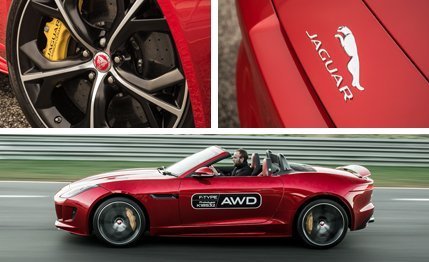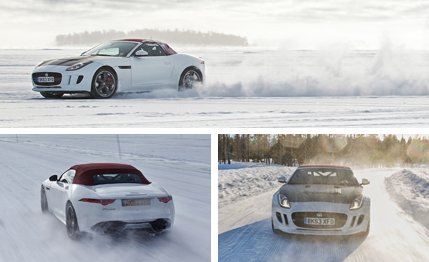
 First Drive Review
First Drive Review
One of these days our Save the Manuals campaign will arrive at its inevitable end. Even if the ol’ stick shift wins a battle every now and then, newer, smoother, and faster transmission technology is dominating the war. We’ll be devastated to concede victory, but our work as the enthusiasts’ advocate won’t end with manual transmissions. That’s because there’s another just cause waiting in the wings. We’d call it our Save Rear-Wheel Drive Movement. As power escalates to obscene levels, carmakers are sending torque to all four wheels to get that grunt to the ground. Going fast is great, but all-wheel-drive systems also add weight and compromise handling.
Which brings us to the 2016 Jaguar F-type coupe and convertible, cars that simultaneously fight the good fight and force all-wheel drive onto a sublime rear-drive sports car. Two years after the F-type debuted, a six-speed manual is optional with some engines while other powertrains are now mated with all-wheel drive as standard equipment.
We’ll hedge the bad news with some good: For 2016, the F-type V-8 S convertible is now an F-type R convertible, meaning it gets a power boost to match the coupe, going from 495 horsepower and 460 lb-ft of torque to 550 and 502. The downside is that all-wheel drive is now standard on all eight-cylinder F-types, both coupes and convertibles, regardless of whether they’re sold in Vermont or Florida. (Rear-drive Rs still will be available elsewhere in the world.)


Jaguar believes you need four driven wheels to control the fury of the 5.0-liter supercharged V-8, and frankly, they’re not totally wrong. But the F-type derives a certain amount of charm from its tail-happy attitude and slightly juvenile inability to put the power to the ground. Besides, there will always be quicker ways than an F-type to get to 60 mph or to lap a track for $100,000 (such as the definitely-not-all-wheel-drive Chevrolet Corvette Z06). And at 176 pounds, the all-wheel-drive hardware does nothing to help the F-type’s serious weight problem. When we get our hands on one for testing, expect this two-passenger aluminum coupe to weigh in excess of 4000 pounds.
The all-wheel-drive system, which is also an option on the 380-hp supercharged V-6 S model, can deliver up to 50 percent of the torque to the front wheels through an electronically controlled clutch pack or decouple the prop shaft completely to drive only the rear wheels in low-load, straight-ahead situations. While the four-wheel-drive F-type will still swish its tail around, breaking the rear end loose takes a concerted effort. The real benefit, of course, is the ability to drive out of corners with more throttle—and to apply it earlier.


We lapped Portugal’s Estoril circuit in an F-type R and a low-speed handling course with a V-6 S coupe in a parking lot saturated by garden sprinklers. In the wet or dry, the all-wheel-drive F-type is far more stable and easier to drive at corner exit. There’s even enough traction to do a full-throttle launch in the wet with no evidence of wheelspin. For those who treat driving fast as a point-and-shoot exercise, an all-wheel-drive F-type R will probably save a few insurance claims. To us, though, it seems a bit stifling for Jaguar to foist all-wheel-drive on Sun Belt buyers and three-season drivers in the north.
All 2016 F-types switch from hydraulic power steering to electric power steering, and the outcome is far better than we could have anticipated. While it’s not quite as perfectly weighted as the setup in the sublime 2017 Jaguar XE, the F-type’s steering is precise, sharp on-center, and full of feedback. The effort is a touch light for our tastes, but that doesn’t prevent Jaguar from joining the rarefied company of automakers that have improved their steering with the switch to electric assistance.


While the V-8 models are losing some of their driver’s-car appeal, the V-6 models gain credibility by way of an optional six-speed manual transmission. The stick shift is available on both the 340- and 380-hp V-6 models, but exclusively with rear-wheel drive. For the privilege of working the clutch pedal, buyers can expect a discount of about $1500 and a savings of 22 pounds compared with the eight-speed automatic.
A light clutch pedal doesn’t offer much feedback as to where the friction point begins or how the clutch engages, and the shifter’s throws are on the long side, with a slightly elastic resistance to every movement. It’s all a bit reminiscent of a BMW shifter, which is to be expected considering that both Jag and BMW source their manual transmissions from supplier ZF. Overall, we’d call the gearbox action good but not Honda-great. Then again, anything with three pedals is pretty great, and there are few luxuries greater than choice. So considering the F-type R’s switch to all-wheel drive, all the time, we say the V-6 S is the F-type to buy for now.